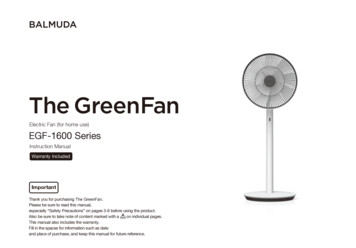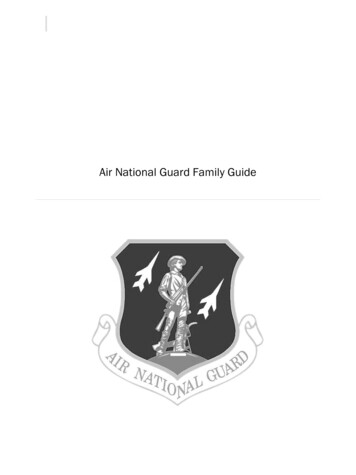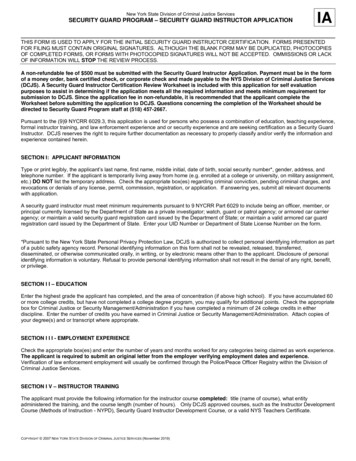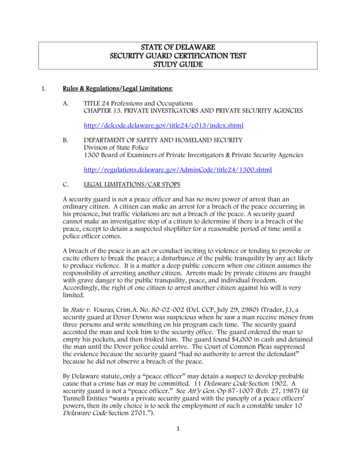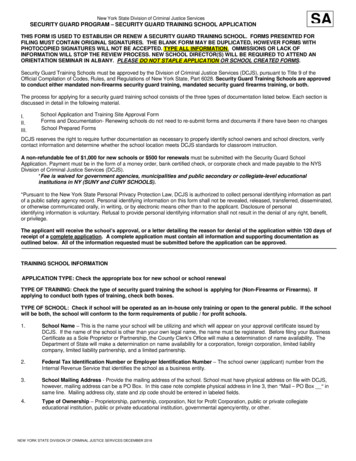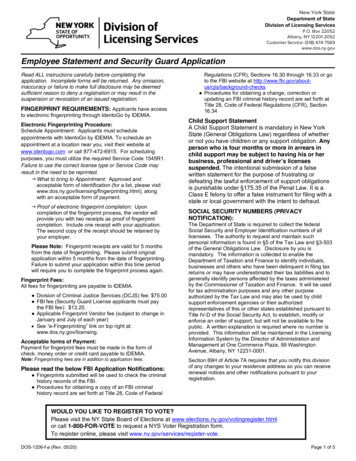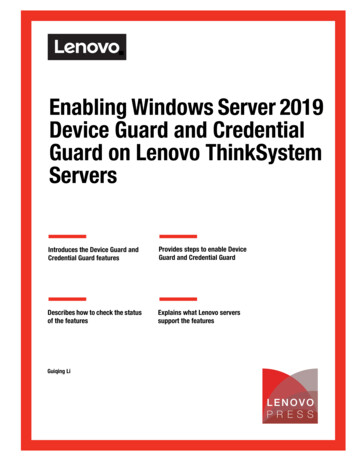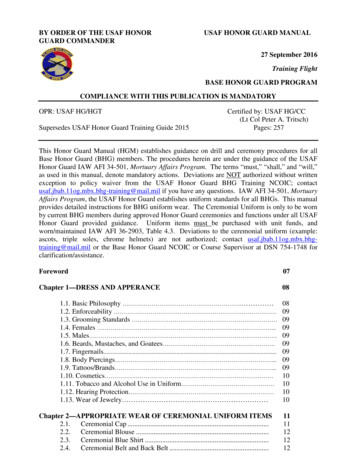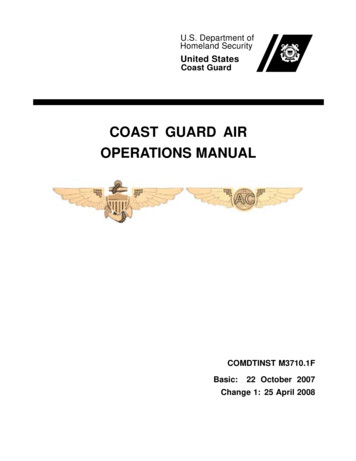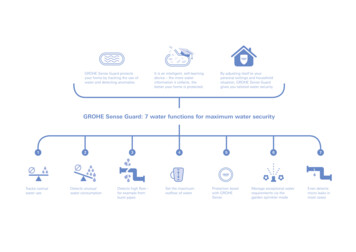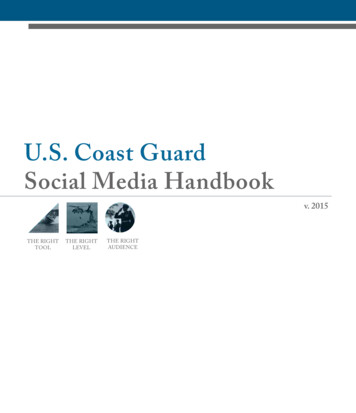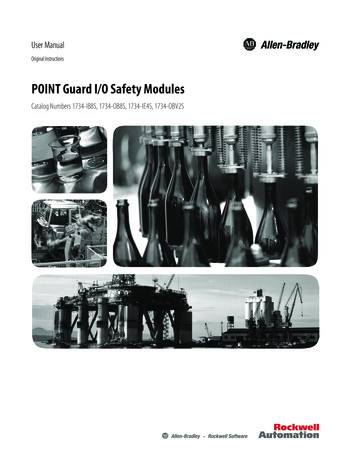
Transcription
User ManualOriginal InstructionsPOINT Guard I/O Safety ModulesCatalog Numbers 1734-IB8S, 1734-OB8S, 1734-IE4S, 1734-OBV2S
Important User InformationRead this document and the documents listed in the additional resources section about installation, configuration, andoperation of this equipment before you install, configure, operate, or maintain this product. Users are required tofamiliarize themselves with installation and wiring instructions in addition to requirements of all applicable codes, laws,and standards.Activities including installation, adjustments, putting into service, use, assembly, disassembly, and maintenance arerequired to be carried out by suitably trained personnel in accordance with applicable code of practice.If this equipment is used in a manner not specified by the manufacturer, the protection provided by the equipment maybe impaired.In no event will Rockwell Automation, Inc. be responsible or liable for indirect or consequential damages resulting fromthe use or application of this equipment. In case of malfunction or damage, no attempts at repair should be made. Themodule should be returned to the manufacturer for repair. Do not dismantle the module.The examples and diagrams in this manual are included solely for illustrative purposes. Because of the many variables andrequirements associated with any particular installation, Rockwell Automation, Inc. cannot assume responsibility orliability for actual use based on the examples and diagrams.No patent liability is assumed by Rockwell Automation, Inc. with respect to use of information, circuits, equipment, orsoftware described in this manual.Reproduction of the contents of this manual, in whole or in part, without written permission of Rockwell Automation,Inc., is prohibitedThroughout this manual, when necessary, we use notes to make you aware of safety considerations.WARNING: Identifies information about practices or circumstances that can cause an explosion in a hazardousenvironment, which may lead to personal injury or death, property damage, or economic loss.ATTENTION: Identifies information about practices or circumstances that can lead to personal injury or death, propertydamage, or economic loss. Attentions help you identify a hazard, avoid a hazard, and recognize the consequence.IMPORTANTIdentifies information that is critical for successful application and understanding of the product.Labels may also be on or inside the equipment to provide specific precautions.SHOCK HAZARD: Labels may be on or inside the equipment, for example, a drive or motor, to alert people that dangerousvoltage may be present.BURN HAZARD: Labels may be on or inside the equipment, for example, a drive or motor, to alert people that surfaces mayreach dangerous temperatures.ARC FLASH HAZARD: Labels may be on or inside the equipment, for example, a motor control center, to alert people topotential Arc Flash. Arc Flash will cause severe injury or death. Wear proper Personal Protective Equipment (PPE). Follow ALLRegulatory requirements for safe work practices and for Personal Protective Equipment (PPE).
Table of ContentsPrefaceSummary of Changes . . . . . . . . . . . . . . . . . . . . . . . . . . . . . . . . . . . . . . . . . . . 9Terminology . . . . . . . . . . . . . . . . . . . . . . . . . . . . . . . . . . . . . . . . . . . . . . . . . . . 9Additional Resources . . . . . . . . . . . . . . . . . . . . . . . . . . . . . . . . . . . . . . . . . . 10Chapter 1POINT Guard I/O OverviewUnderstand Suitability for Use . . . . . . . . . . . . . . . . . . . . . . . . . . . . . . . . .Safety Precautions . . . . . . . . . . . . . . . . . . . . . . . . . . . . . . . . . . . . . . . . . . . . .Installing and Replacing Modules . . . . . . . . . . . . . . . . . . . . . . . . . . .Securing the System. . . . . . . . . . . . . . . . . . . . . . . . . . . . . . . . . . . . . . . .POINT Guard I/O Modules in CIP Safety Systems . . . . . . . . . . . . . .1734-IB8S Digital Input Module Features . . . . . . . . . . . . . . . . . . .1734-OB8S Safety Digital Output Module Features . . . . . . . . . .1734-OBV2S POINT Guard I/O Module Features . . . . . . . . . .1734-IE4S Safety Analog Input Module Features. . . . . . . . . . . . .Programming Requirements. . . . . . . . . . . . . . . . . . . . . . . . . . . . . . . .CIP Safety Architectures . . . . . . . . . . . . . . . . . . . . . . . . . . . . . . . . . . .Safety Application Requirements . . . . . . . . . . . . . . . . . . . . . . . . . . . . . . .111313141515161617171819Chapter 2Safety Inputs, Safety Outputs,and Safety DataSafe States . . . . . . . . . . . . . . . . . . . . . . . . . . . . . . . . . . . . . . . . . . . . . . . . . . . .POINT Guard Digital I/O Modules . . . . . . . . . . . . . . . . . . . . . . . .POINT Guard I/O Analog Input Module . . . . . . . . . . . . . . . . . . .Safety Inputs (1734-IB8S) . . . . . . . . . . . . . . . . . . . . . . . . . . . . . . . . . . . . .Using a Test Output with a Safety Input. . . . . . . . . . . . . . . . . . . . .Single-channel Mode . . . . . . . . . . . . . . . . . . . . . . . . . . . . . . . . . . . . . .Dual-channel Mode and Discrepancy Time . . . . . . . . . . . . . . . . . .Dual-channel, Equivalent . . . . . . . . . . . . . . . . . . . . . . . . . . . . . . . . . .Dual-channels, Complementary . . . . . . . . . . . . . . . . . . . . . . . . . . . .Safety Input Fault Recovery . . . . . . . . . . . . . . . . . . . . . . . . . . . . . . . .Input Delays . . . . . . . . . . . . . . . . . . . . . . . . . . . . . . . . . . . . . . . . . . . . . .Safety Analog Inputs (1734-IE4S) . . . . . . . . . . . . . . . . . . . . . . . . . . . . . .Input Range. . . . . . . . . . . . . . . . . . . . . . . . . . . . . . . . . . . . . . . . . . . . . . .Scaling. . . . . . . . . . . . . . . . . . . . . . . . . . . . . . . . . . . . . . . . . . . . . . . . . . . .Digital Input Filter . . . . . . . . . . . . . . . . . . . . . . . . . . . . . . . . . . . . . . . .Sensor Power Supply. . . . . . . . . . . . . . . . . . . . . . . . . . . . . . . . . . . . . . .Channel Offset. . . . . . . . . . . . . . . . . . . . . . . . . . . . . . . . . . . . . . . . . . . .Process Alarms . . . . . . . . . . . . . . . . . . . . . . . . . . . . . . . . . . . . . . . . . . . .Using a Single-channel Sensor . . . . . . . . . . . . . . . . . . . . . . . . . . . . . .Dual-channel Equivalent Mode . . . . . . . . . . . . . . . . . . . . . . . . . . . . .Tachometer Mode. . . . . . . . . . . . . . . . . . . . . . . . . . . . . . . . . . . . . . . . .Safety Outputs (1734-OB8S and 1734-OBV2S) . . . . . . . . . . . . . . . . .Safety Output with Test Pulse . . . . . . . . . . . . . . . . . . . . . . . . . . . . . .Dual-channel Mode . . . . . . . . . . . . . . . . . . . . . . . . . . . . . . . . . . . . . . .Single-channel Mode, 1734-OB8S Only . . . . . . . . . . . . . . . . . . . . .Safety Output Fault Recovery . . . . . . . . . . . . . . . . . . . . . . . . . . . . . .Muting Lamp Operation (1734-IB8S) . . . . . . . . . . . . . . . . . . . . . . . . . .Rockwell Automation Publication 1734-UM013N-EN-P - September 383939403
Table of ContentsI/O Status Data . . . . . . . . . . . . . . . . . . . . . . . . . . . . . . . . . . . . . . . . . . . . . . . 41Digital I/O Status Data . . . . . . . . . . . . . . . . . . . . . . . . . . . . . . . . . . . . 42Analog I/O Status Data . . . . . . . . . . . . . . . . . . . . . . . . . . . . . . . . . . . . 42Chapter 3Guidelines for Placing PowerChoosing a Power Supply . . . . . . . . . . . . . . . . . . . . . . . . . . . . . . . . . . . . . . 43Supplies and Modules in a System Power Supply Examples. . . . . . . . . . . . . . . . . . . . . . . . . . . . . . . . . . . . . . . . 45Example 1: Isolating Field Power Segments . . . . . . . . . . . . . . . . . .Example 2: POINT Guard I/O Used with AC I/O Modules . .Placing Series A Digital and Analog Modules . . . . . . . . . . . . . . . . . . . .Placing Series B Digital Modules. . . . . . . . . . . . . . . . . . . . . . . . . . . . . . . .45464748Chapter 4Install the Module4Precautions . . . . . . . . . . . . . . . . . . . . . . . . . . . . . . . . . . . . . . . . . . . . . . . . . . .European Hazardous Location Approval . . . . . . . . . . . . . . . . . . . .North American Hazardous Location Approval. . . . . . . . . . . . . .Environment and Enclosure . . . . . . . . . . . . . . . . . . . . . . . . . . . . . . . .Prevent Electrostatic Discharge . . . . . . . . . . . . . . . . . . . . . . . . . . . . .Mount the Module . . . . . . . . . . . . . . . . . . . . . . . . . . . . . . . . . . . . . . . . . . . .Install the Mounting Base . . . . . . . . . . . . . . . . . . . . . . . . . . . . . . . . . .Connect the Module to the Mounting Base. . . . . . . . . . . . . . . . . .Connect the Removable Terminal Block . . . . . . . . . . . . . . . . . . . .Remove a Mounting Base . . . . . . . . . . . . . . . . . . . . . . . . . . . . . . . . . .Wire Modules . . . . . . . . . . . . . . . . . . . . . . . . . . . . . . . . . . . . . . . . . . . . . . . .Terminal Layout . . . . . . . . . . . . . . . . . . . . . . . . . . . . . . . . . . . . . . . . . .Connection Details. . . . . . . . . . . . . . . . . . . . . . . . . . . . . . . . . . . . . . . . . . . .Wiring Examples . . . . . . . . . . . . . . . . . . . . . . . . . . . . . . . . . . . . . . . . . . . . . .Emergency Stop Dual-channel Devices . . . . . . . . . . . . . . . . . . . . . .Single-channel Safety Contactor . . . . . . . . . . . . . . . . . . . . . . . . . . . .Dual-channel Safety Contactors . . . . . . . . . . . . . . . . . . . . . . . . . . . .Bipolar Safety Outputs. . . . . . . . . . . . . . . . . . . . . . . . . . . . . . . . . . . . .Safety Analog Input Wiring . . . . . . . . . . . . . . . . . . . . . . . . . . . . . . . .Rockwell Automation Publication 1734-UM013N-EN-P - September 201750515252535353555657575961636364656667
Table of ContentsChapter 5Configure the Module in aGuardLogix Controller SystemSet up the Module. . . . . . . . . . . . . . . . . . . . . . . . . . . . . . . . . . . . . . . . . . . . . 75Add and Configure the Ethernet Bridge. . . . . . . . . . . . . . . . . . . . . . . . . 76Add and Configure the 1734 Ethernet Adapter . . . . . . . . . . . . . . . . . . 77Add and Configure Safety Digital Input Modules . . . . . . . . . . . . . . . . 80Add the Safety Digital Input Module. . . . . . . . . . . . . . . . . . . . . . . . 80Configure the Safety Digital Inputs . . . . . . . . . . . . . . . . . . . . . . . . . 85Configure the Test Outputs . . . . . . . . . . . . . . . . . . . . . . . . . . . . . . . . 88Add and Configure Safety Digital Output Modules . . . . . . . . . . . . . . 89Add the Safety Digital Output Module . . . . . . . . . . . . . . . . . . . . . . 89Configure the Safety Digital Outputs . . . . . . . . . . . . . . . . . . . . . . . 93Add and Configure Safety Analog Input Modules. . . . . . . . . . . . . . . . 94Add the Safety Analog Input Module . . . . . . . . . . . . . . . . . . . . . . . 94Configure the Safety Analog Input Channel Operation . . . . . . . 97Configure the Safety Analog Inputs . . . . . . . . . . . . . . . . . . . . . . . . . 98Configure Safety Analog Input Alarms (Optional) . . . . . . . . . . . 99Configure Tachometer Operation . . . . . . . . . . . . . . . . . . . . . . . . . 101Values and States of Tags . . . . . . . . . . . . . . . . . . . . . . . . . . . . . . . . . . . . . 103Configure Safety Connections. . . . . . . . . . . . . . . . . . . . . . . . . . . . . . . . . 105Configuration Ownership . . . . . . . . . . . . . . . . . . . . . . . . . . . . . . . . . . . . 106Save and Download the Module Configuration . . . . . . . . . . . . . . . . . 107Update POINT Guard I/O Modules . . . . . . . . . . . . . . . . . . . . . . . . . . 107Chapter 6Configure the Module for aSmartGuard ControllerBefore You Begin. . . . . . . . . . . . . . . . . . . . . . . . . . . . . . . . . . . . . . . . . . . . . 110Set the Node Address . . . . . . . . . . . . . . . . . . . . . . . . . . . . . . . . . . . . . . . . . 110Auto-addressing with a 1734-PDN Adapter . . . . . . . . . . . . . . . . . . . . 112Set Up Your DeviceNet Network. . . . . . . . . . . . . . . . . . . . . . . . . . . . . . 114Configure the POINT Guard I/O Modules . . . . . . . . . . . . . . . . . . . . 115Configure Digital Safety Inputs and Test Outputs. . . . . . . . . . . 115Configure Digital Safety Outputs . . . . . . . . . . . . . . . . . . . . . . . . . . 118Configure Safety Analog Inputs. . . . . . . . . . . . . . . . . . . . . . . . . . . . 119Configure the SmartGuard Controller . . . . . . . . . . . . . . . . . . . . . . . . . 124Set Up the Input and Output Connections . . . . . . . . . . . . . . . . . 124Complete the Set Up of the SmartGuard Controller. . . . . . . . . 128Save and Download Module Configuration . . . . . . . . . . . . . . . . . . . . 129Rockwell Automation Publication 1734-UM013N-EN-P - September 20175
Table of ContentsChapter 7Configuring Safety Connectionsbetween a GuardLogix Controllerand POINT Guard I/O Modules on aDeviceNet NetworkConfigure the Module in RSNetWorx for DeviceNet Software . . 131Add the POINT Guard I/O Module to the Controller Project. . . 132Complete the Safety Configuration . . . . . . . . . . . . . . . . . . . . . . . . . . . . 136Download the DeviceNet Network Configuration . . . . . . . . . . . . . . 138Verify Your DeviceNet Safety Configuration . . . . . . . . . . . . . . . . . . . 139Determine If Devices Can Be Verified . . . . . . . . . . . . . . . . . . . . . . 140Select Devices to Verify . . . . . . . . . . . . . . . . . . . . . . . . . . . . . . . . . . . 141Review the Safety Device Verification Reports . . . . . . . . . . . . . . 143Lock Safety Devices. . . . . . . . . . . . . . . . . . . . . . . . . . . . . . . . . . . . . . . 143Chapter 8Replacing POINT GuardI/O ModulesThe Safety Network Number . . . . . . . . . . . . . . . . . . . . . . . . . . . . . . . . . 145Manually Setting the Safety Network Number. . . . . . . . . . . . . . . . . . 146Resetting a Module to Out-of-box Condition. . . . . . . . . . . . . . . . . . . 147By Using the Logix Designer Application . . . . . . . . . . . . . . . . . . . 148By Using RSNetWorx for DeviceNet Software. . . . . . . . . . . . . . 149Replace a Module in a GuardLogix Systemon an EtherNet/IP Network . . . . . . . . . . . . . . . . . . . . . . . . . . . . . . . . . . 150Replacement with Configure Only When No SafetySignature Exists’ Enabled . . . . . . . . . . . . . . . . . . . . . . . . . . . . . . . . . . 150Replacement with ‘Configure Always’ Enabled. . . . . . . . . . . . . . 155Replace a Module When Using a SmartGuard or GuardLogixController on a DeviceNet Network . . . . . . . . . . . . . . . . . . . . . . . . . . . 157Appendix AIndicators6Module . . . . . . . . . . . . . . . . . . . . . . . . . . . . . . . . . . . . . . . . . . . . . . . . . . . . . 162Network Status . . . . . . . . . . . . . . . . . . . . . . . . . . . . . . . . . . . . . . . . . . . . . . 163Configuration Lock . . . . . . . . . . . . . . . . . . . . . . . . . . . . . . . . . . . . . . . . . . 163Power . . . . . . . . . . . . . . . . . . . . . . . . . . . . . . . . . . . . . . . . . . . . . . . . . . . . . . . 1631734-IE4S Sensor Power. . . . . . . . . . . . . . . . . . . . . . . . . . . . . . . . . . . . . . 1631734-IE4S Safety Analog Input Status . . . . . . . . . . . . . . . . . . . . . . . . . 1641734-IB8S Safety Input Status. . . . . . . . . . . . . . . . . . . . . . . . . . . . . . . . . 1641734-OB8S Safety Output Status. . . . . . . . . . . . . . . . . . . . . . . . . . . . . . 1651734-OBV2S Safety Output Status . . . . . . . . . . . . . . . . . . . . . . . . . . . . 165Rockwell Automation Publication 1734-UM013N-EN-P - September 2017
Table of ContentsAppendix BGet I/O Diagnostic Status fromModules in Logix SystemsMessage Instructions . . . . . . . . . . . . . . . . . . . . . . . . . . . . . . . . . . . . . . . . . 167Configure the Message Instruction . . . . . . . . . . . . . . . . . . . . . . . . . . . . 168Class, Instance, and Attribute Data for I/O Modules . . . . . . . . . . . . 169Appendix CSpecificationsTechnical Specifications for Series A Modules . . . . . . . . . . . . . . . . . . 173Safety Digital Input Module Specifications . . . . . . . . . . . . . . . . . 173Safety Digital Output Module Specifications. . . . . . . . . . . . . . . . 175Safety Analog Input Module Specifications . . . . . . . . . . . . . . . . . 176Technical Specifications for Series B Modules . . . . . . . . . . . . . . . . . . 185Safety Digital Input Module Specifications . . . . . . . . . . . . . . . . . 185Safety Digital Output Module Specifications. . . . . . . . . . . . . . . . 188Safety Digital Output Module Specifications 1734-OBV2S . . . . . . 190Environmental Specifications . . . . . . . . . . . . . . . . . . . . . . . . . . . . . . . . . 192Certifications . . . . . . . . . . . . . . . . . . . . . . . . . . . . . . . . . . . . . . . . . . . . . . . . 195Standards. . . . . . . . . . . . . . . . . . . . . . . . . . . . . . . . . . . . . . . . . . . . . . . . . . . . 195Appendix DSafety Data. . . . . . . . . . . . . . . . . . . . . . . . . . . . . . . . . . . . . . . . . . . . . . . . . . . . . . . . . . . . . 197Series A Safety Data . . . . . . . . . . . . . . . . . . . . . . . . . . . . . . . . . . . . . . . . . . 198Series B Safety Data . . . . . . . . . . . . . . . . . . . . . . . . . . . . . . . . . . . . . . . . . . 201Product Failure Rates (failures per hour) . . . . . . . . . . . . . . . . . . . . . . . 205Appendix EConfiguration Parameters. . . . . . . . . . . . . . . . . . . . . . . . . . . . . . . . . . . . . . . . . . . . . . . . . . . . . . . . . . . . . 207Appendix FI/O AssembliesInput Assemblies . . . . . . . . . . . . . . . . . . . . . . . . . . . . . . . . . . . . . . . . . . . . . 211Output Assemblies . . . . . . . . . . . . . . . . . . . . . . . . . . . . . . . . . . . . . . . . . . . 213Analog Input Assemblies. . . . . . . . . . . . . . . . . . . . . . . . . . . . . . . . . . . . . . 213Configuration Assemblies. . . . . . . . . . . . . . . . . . . . . . . . . . . . . . . . . . . . . 215Using Data from Modules Configured Via the Generic Profile . . . 221Index. . . . . . . . . . . . . . . . . . . . . . . . . . . . . . . . . . . . . . . . . . . . . . . . . . . . . . . . . . . . . 223Rockwell Automation Publication 1734-UM013N-EN-P - September 20177
Table of ContentsNotes:8Rockwell Automation Publication 1734-UM013N-EN-P - September 2017
PrefaceThoroughly read and understand this manual before installing and operating asystem that uses POINT Guard I/O modules.Always observe the following guidelines when using a module. In this manual, weuse safety administrator to mean a person who is qualified, authorized, andresponsible to secure safety in the design, installation, operation, maintenance,and disposal of the ‘machine’. Keep this manual in a safe place where personnel can refer to it whennecessary. Use the module properly according to the installation environment,performance ratings, and functions of the machine.See Understand Suitability for Use on page 11 and Safety Precautions onpage 13.Product specifications and accessories can change at any time. Consult with yourRockwell Automation representative to confirm specifications of purchasedproduct. Dimensions and weights are nominal and are not for manufacturingpurposes, even when tolerances are shown.Consult your Rockwell Automation representative if you have any questions orcomments. Also refer to the related documentation, which is listed on page 10, asnecessary.Summary of ChangesTerminologyWe updated the ATTENTION statement on grounding on page 58.Table 1 - Common TermsTermMeansConnectionLogical communication channel for communication between nodes. Connections aremaintained and controlled between masters and slaves.EDSElectronic data sheet, a template that is used in RSNetWorx software to display theconfiguration parameters, I/O data profile, and connection-type support for a given I/Omodule. RSNetWorx software uses these simple text files to identify products andcommission them on a network.ODVAOpen DeviceNet Vendor Association, a nonprofit association of vendors that are establishedfor the promotion of CIP networks.PFDProbability of failure on demand, the average probability of a system to fail to perform itsdesign function on demand.PFHProbability of failure per hour, the probability of a system to have a dangerous failure occurper hour.Proof testPeriodic test that detects failures in a safety-related system so that, if necessary, the systemcan be restored to an as-new condition or as close as practical to this condition.SNNSafety network number, which uniquely identifies a network across all networks in thesafety system. You are responsible for assigning a unique number for each safety network orsafety subnet within a system.StandardDevices or portions of devices that do not participate in the safety function.Rockwell Automation Publication 1734-UM013N-EN-P - September 20179
PrefaceAdditional ResourcesThese documents contain additional information concerning related productsfrom Rockwell Automation.ResourceDescriptionPOINT I/O Selection Guide, publication 1734-SG001Provides selection information for POINT I/O modules. Additional publication referencesare listed as well.GuardLogix 5570 Controllers User Manual, publication 1756-UM022Provides information on how to install, configure, program, and use GuardLogix 5570controllers in Studio 5000 Logix Designer projects.GuardLogix 5570 Controller Systems Safety Reference Manual, publication 1756-RM099Provides information on safety application requirements for GuardLogix 5570 controllersin Studio 5000 Logix Designer projects.GuardLogix Controller Systems Safety Reference Manual, publication 1756-RM093Provides information on safety system requirements and describes the GuardLogix controller system.GuardLogix Controllers User Manual, publication 1756-UM020Provides information on how to install, configure, program, and use GuardLogixcontrollers in RSLogix 5000 projects.GuardLogix Safety Application Instructions Safety Reference Manual,publication 1756-RM095Provides reference information that describes the GuardLogix Safety ApplicationInstruction Set.SmartGuard 600 Controllers Safety Reference Manual, publication 1752-RM001Describes SmartGuard 600-specific safety requirements and controller features.Field Potential Distributor Installation Instructions, publication 1734-IN059Provides installation information on 1734-FPD distributors.POINT I/O 24V DC Expansion Power Supply Installation Instructions,publication 1734-IN058Provides installation information on 1734-EP24DC power supplies.POINT I/O 120/240V AC Expansion Power Supply Installation Instructions,publication 1734-IN017Provides installation information on 1734-EPAC power supplies.POINT I/O Wiring Base Assembly Installation Instructions, publication 1734-IN511Provides installation information on 1734-TB and 1734-TBS assemblies.POINT I/O One-piece Wiring Base Assembly Installation Instructions,publication 1734-IN028Provides installation information on 1734-TOP, 1734-TOPS, 1734-TOP3, and 1734-TOP3Sassemblies.ODVA Media Planning and Installation Guide, http://www.odva.orgDescribes the required media components and how to plan for and install these requiredcomponents.Industrial Automation Wiring and Grounding Guidelines, publication 1770-4.1Provides general guidelines for installing a Rockwell Automation industrial system.Product Certifications website, tion/overview.pageProvides declarations of conformity, certificates, and other certification details.You can view or download publications athttp://www.rockwellautomation.com/literature/. To order paper copies oftechnical documentation, contact your local Allen-Bradley distributor orRockwell Automation sales representative.10Rockwell Automation Publication 1734-UM013N-EN-P - September 2017
Chapter1POINT Guard I/O OverviewTopicPageUnderstand Suitability for Use11Safety Precautions13POINT Guard I/O Modules in CIP Safety Systems15Safety Application Requirements19Use the POINT Guard I/O safety modules in the POINT I/O platform todistribute safety I/O on a safety-control network that meets the requirements upto and including SIL CL3, and PLe, Cat. 4 as defined in IEC 61508, IEC 61511,IEC 62061, and ISO 13849-1. Guard I/O modules can be used withGuardLogix controllers, Compact GuardLogix controllers, and SmartGuard Controllers.You can configure the modules for use on DeviceNet networks by using thenetwork configuration tool, RSNetWorx for DeviceNet software. For Ethernetnetworks, use the GuardLogix programming tool, the Logix Designerapplication.Understand Suitability forUseRockwell Automation is not responsible for conformity with any standards,codes, or regulations that apply to the combination of the products in yourapplication or use of the product. See Standards on page 195 for moreinformation.Take all necessary steps to determine the suitability of the products for thesystems, machine, and equipment with which it is used.Know and observe all prohibitions of use applicable to these products.Use this equipment within its specified ratings.Never use these products for an application that involves serious risk to life orproperty without making sure that the system as a whole was designed to addressthe risks. Be sure that Rockwell Automation products are properly rated andinstalled for the intended use within the overall equipment or system.Only download firmware and access product release notes from the RockwellAutomation official download portal at on/support/pcdc.page.Do not download firmware from non-Rockwell Automation sites.Rockwell Automation Publication 1734-UM013N-EN-P - September 201711
Chapter 1POINT Guard I/O OverviewVerify that the POINT Guard I/O firmware revision is correct before youcommission the safety system. Firmware information for safety I/O modules isavailable fication/safety.TIPField power must be applied to the 1734-IE4S module when updatingfirmware.Verify that a safety administrator conducts a risk assessment on the machine anddetermines module suitability before installation.ATTENTION: Personnel responsible for the application of safety-relatedprogrammable electronic systems (PES) shall be aware of the safetyrequirements in the application of the system and shall be trained in the use ofthe system.ATTENTION: Use only appropriate components or devices that comply withrelevant safety standards that correspond to the required safety category andsafety integrity level. Conformity to requirements of the safety category and safety integrity levelmust be determined for the entire system. We recommend that you consult a certification body regarding assessment ofconformity to the required safety integrity level or safety category.You are responsible for confirming compliance with the applicable standards forthe entire system.Table 1 - Requirements for Controlling DevicesDeviceEmergency stop switchesDoor interlocking switches,limit switchesSafety sensorsRelays with forcibly- guidedcontacts, contactorsOther devices12RequirementUse approved devices with direct opening mechanisms that comply with IEC/EN60947-5-1.Use approved devices with direct opening mechanisms that comply with IEC/EN60947-5-1 and capable of switching microloads of24V DC, 3 mA.Use approved devices that comply with the relevant product standards, regulations,and rules in the country where used.Use approved devices with forcibly guided contacts that comply with EN 50205. Forfeedback purposes, use devices with contacts capable of switching micro loads of24V DC, 3 mA.Evaluate whether devices used are appropriate to satisfy the requirements of safetycategory levels.Allen-Bradley Bulletin Safety ComponentsBulletin 800F, 800TBulletin 440K, 440G, 440H for interlock switchBulletin 440P, 802T for limit switchAny Guardmaster productBulletin 700S, 100S-Rockwell Automation Publication 1734-UM013N-EN-P - September 2017
POINT Guard I/O OverviewSafety PrecautionsChapter 1Observe these precautions for proper use of POINT Guard I/O modules.ATTENTION: As serious injury can occur due to loss of required safety function,follow these safety precautions. Never use test outputs as safety outputs. Test outputs are not safety outputs. Do not use Ethernet, DeviceNet, or ControlNet standard I/O data or explicitmessage data as safety data. Do not use light-emitting diode (LED) status indicators on the I/O modules forsafety operations. Do not connect loads beyond the rated value to the safety outputs. Apply properly specified voltages to the module. Applying inappropriatevoltages can cause the module to fail to perform it’s specified function, whichcould lead to loss of safety functions or damage to the module. Wire the POINT Guard I/O modules properly following the wiring requirementsand guidelines in Wire Modules on page 57. Set unique network node addresses before connecting devices to the network. Perform testing to confirm that device wiring, configuration, and operation iscorrect before starting system operation. Do not disassemble, repair, or modify the module. This can result in loss ofsafety functions.Installing and Replacing ModulesATTENTION: Clear previous configuration data before connecting devices to the network orconnecting input or output power to the device. Configure the replacement device properly and confirm that it operatescorrectly. After installation of the module, a safety administrator must confirm theinstallation and conduct trial operation and maintenance.When you clean a module, do not use the following: Thinn
6 Rockwell Automation Publication 1734-UM013N-EN-P - September 2017 Table of Contents Chapter 7 Configuring Safety Connections between a GuardLogix Controller and POINT Guard I/O Modules on a DeviceNet Network Configure the Module in RSNetWorx for DeviceNet Software . . 131
